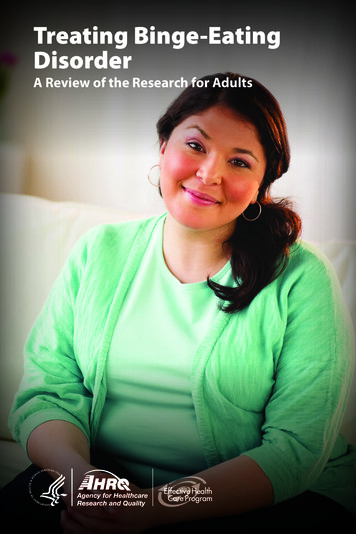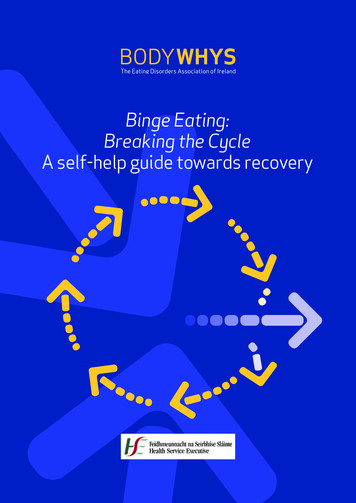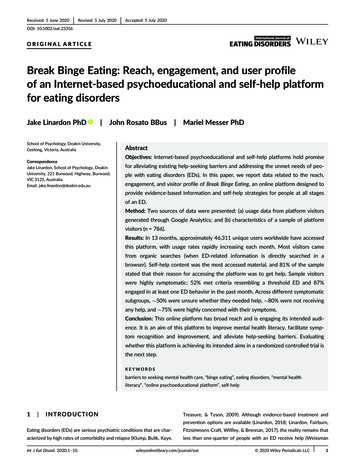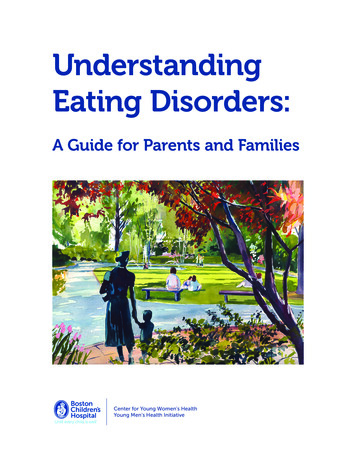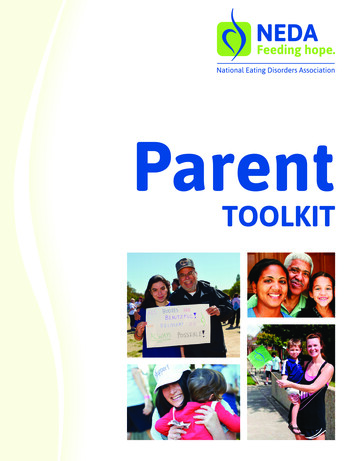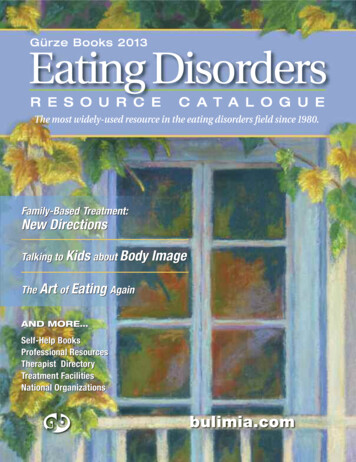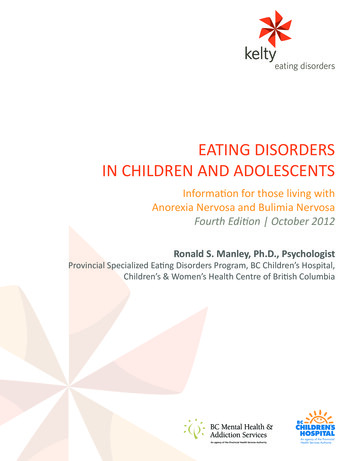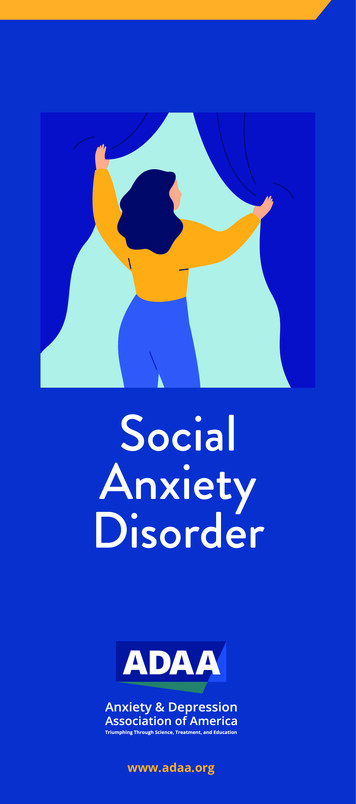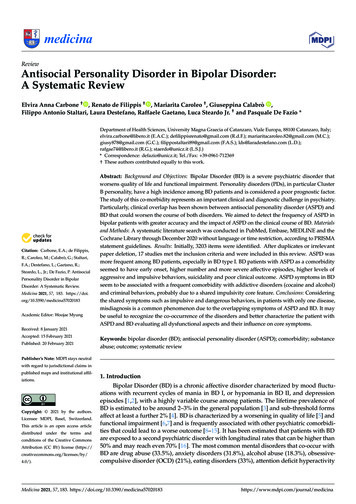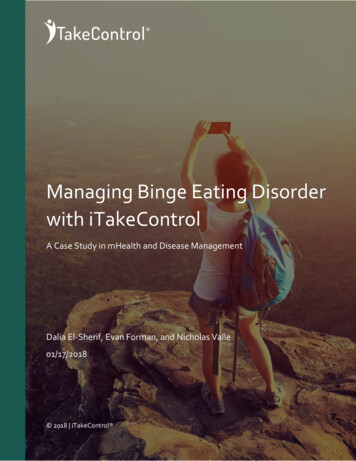
Transcription
Managing Binge Eating Disorderwith iTakeControlA Case Study in mHealth and Disease ManagementDalia El-Sherif, Evan Forman, and Nicholas Valle01/17/2018 2018 iTakeControl 0
Mobile health applications are still in their infancy, but present a great opportunity for the healthcareindustry. They enable patients to have a greater role in their health, empower providers to makedata-driven decisions, allow researchers to gain greater insight into patient and disease populations,and give payers a new window into how patients are doing on treatment. With a multitude of conditions anddisorders that require consistent support from medical professionals, not all patients can easily provide data orhave access to the resources they need. In this paper, we explore how a mobile application can help bridge thisgap by reviewing data obtained through iTakeControl Binge, a mobile health application focused on BingeEating Disorder.Eating disorders (ED), are prevalent; however, only17-23% of these individuals receive treatment for it(1), leaving others to struggle with their disorderwithout professional help. While direct treatmentwith a healthcare professional is the best course forpatients with an eating disorder, access toresources and tools that can aid in the managementof a disorder can benefit patients who wouldotherwise go untreated.loss of control. One of the most effectivetreatments for BED is cognitive behavioral therapy(CBT). A study looking to evaluate the effectivenessof patients with BED recently found that a fewformats of CBT, including guided self-help, “weresuperior to placebo in achieving abstinence andreducing binge frequency.” (3)iTakeControl Binge is a mobile application designedto provide a comprehensive disease managementtool that delivers a guided program based on CBT,along with other critical support tools in the palm ofthe patient’s hands. The app includes resources andcontent to support them in the management oftheir condition at times when they are seekingsupport. iTakeControl Binge is available on bothiPhone and Android mobile devices. However thispaper is focused exclusively on data from iPhoneusers.There are several different types of eatingdisorders, including but not limited to Anorexia,Bulimia, and Binge Eating. Each eating disorder ischaracterized by different symptoms and requires adifferent management plan. Binge Eating Disorder(BED) is the most prevalent eating disorder with arate of 1.9%, affecting approximately 105 millionpeople globally (2); it is characterized by frequentepisodes of overeating accompanied by feelings of1
users are primarily from the United States, UnitedKingdom, Australia, and Canada. However, moresurprisingly, we found a significant number of userslocated in Italy, even though the application is notyet available in Italian. While we can not draw anyconcrete conclusions from this data, we cancertainly generate a few insights that can helpinform the healthcare industry about the globaldemographics of this disease population.iTakeControl User DemographicsGeographic DemographicsiTakeControl Binge was made available through theApple app store, where users were able to accessthe application globally free of charge. Anyindividual with an iPhone device is able to use themobile application. As one of the top 5 searchresults in the app store for “Binge eating,” themajority of users are assumed to have found theapplication via direct search and have proceeded todownload and register in the app. Understandingthe global availability of the app, we can examine itsusage as one data set for a real-world view of thedemographics of this specific patient population.Furthermore, iTakeControl Binge can informdisease demographics at a more regional level.Taking a focused view of the demographics withinthe US, we see that the majority of users from theCurrently, iTakeControl Binge is only available inEnglish. Hence, we would expect the majority ofusers to come from English speaking countries. Inanalyzing the user community to date foriTakeControl Binge, we see that a large portion of2
United States are primarily concentrated in the Eastand West coast, with other large cities such asChicago, Houston, and Minneapolis also presentingsome fairly large user groups.users of the application. Women represented themajority (95%) of iTakeControl Binge users.From an age perspective, approximately 74% ofiTakeControl Binge users are below the age of 35.Nineteen was the age with the highest number ofusers, representing 11% of iTakeControl Bingeusers.Gender and Age DemographicsIn addition to the geographic data, basicdemographics provided paint a better picture of the3
iTakeControl User BehaviorComprehensive Support and Areas of InterestiTakeControl Binge provides a comprehensiveBinge Eating Disorder Management program,including 12 key features: Learning – content providing a step by stepprogram to manage BEDCoping – Content with strategies formanaging BEDData Entry – Ability to record dataincluding; binges, exercise, weight, meals,and emotionsGoals – create and assign goalsTools – enter and manage text entries,including triggers and activitiesProgress – track progress of data entered inData EntrySocial feed – read and comment on postsfrom other usersJournal – write/ record personal or socialjournal entriesProfile – manage individual alias, password,and permissionsMotivators – manage motivating images inthe applicationPoints – track your progress in using theapplicationVideos – watch videos developed by expertsin BEDData Monitoring & Binge BehaviorThere is a lot of data and information that is trackedwithin iTakeControl Binge.In an analysis of the usage of the app, sectionsvisited by users were further examined tounderstand the content and tools that Binge Eatingpatients visited most frequently. Data indicatesthat users spent the most amount of time in thelearning and coping sections of the mobile app,which provided the content on BED and strategiesto manage it. The average amount of time spent persession on the application was over 7 minutesamong all users and a little over 6 minutes amongreturning users.One of the key metrics that iTakeControl tracks is auser-reported “binge” event. Users have the abilityto indicate whether they “yes” had a binge today or“No” they did not Binge. Users are encouraged tomake a report every day, but are not required to doso. Analysis of the overall binge events reportedamong all users indicated that, they bingeapproximately 35% of total reports. A second keydata element we collect is the “urge to binge.” Thisfield is an option for any user submitting a binge4
event. When we did a deeper dive on the Urge tobinge within the 35% of binge events reported, wesee a clear trend, the proportion of bingeingincreased based on the urge to binge, with only 9%of users bingeing when their urge was zero, but 75%of users reporting a binge when they had an urge of5.who entered their binge behaviors into 3 groupsbased on their engagement with the application:1) General: a group consisting of users who madeentries but never completed the learning program2) Dedicated: a group of users who completed theentire learning program3) Highly Dedicated: a final group who completedthe entire learning program and maintained ahigher level of engagement (accessing content,entering data, making journal entries, etc.)Examining the binge behavior among these groups,we found that there is a potential signal ofimprovement in the percentage of users whobinged from one group to another. “General” userswho did not complete the program had the highestpercentage of binges among the three groups at36%. “Dedicated” users had a lower percentage ofbinges then the “General” group at 31%, while“Highly Dedicated” users had the lowestpercentage of binges than the other two groups at20%. So while we did observe a decrease inbingeing between “General” and “Dedicated”users, the data suggests that greater engagementwithin the application has the potential tocontribute to a lower incidence of binges.Does self-guided CBT learning help?In an effort to do an exploratory analysis of how thebingeing behavior differed among users, weanalyzed whether or not there is a correlation onbinge events or urge from the application’s learningprogram. The program built into iTakeControl isdesigned on a step by step basis, requiring users tocomplete one section, before moving to the nextone. The program guides users through a 16 stepprogram that is split across 5 program stages. Asusers progress and unlock sections of the program,they are instructed to monitor their activities in theapplication through the Data Entry section.Users are able to progress through the program attheir own pace and over 50% of them have made itthrough the first four steps of the program, withapproximately 15% completing the program.To compare and further understand the potentialimpact of following a program and utilizing thefeatures of the app, we decided to divide all users5
provide a greater understanding of the challengeswith BED. We created a word cloud to capture themajor themes in the social conversations. While“binge” was the primary theme, other words alsostood out, and will lead to the need for furtherexploration into the nature, patterns, andobservations users contribute.Social SupportIn addition to learning and monitoring theirprogress, users were are also provided an opt-insocial support system within the iTakeControlapplication. As an independent social feed networkfor users of iTakeControl Binge Only, several usershave taken the opportunity to share comments,anecdotes, and support to one another through thefeed. Users can post with their personalized Alias toother members of the community.ConclusionAs mobile devices have gained traction and new usecases continue to present themselves, there issignificant opportunity to use the medium forfurther exploration and data collection.iTakeControl Binge is providing a platform withtools to assist those suffering from BED. With a selfguided program based on CBT, users have theability to follow a program at their own pace, tracktheir progress, and engage with other users.We will continue to analyze the data in order tofurther explore the benefits of utilizing theapplication for the management of binge eating.We look forward to continuing the exploration ofthese and other questions in order to understand ifcognitive behavior therapy and individualengagement through a mobile application can helpusers manage their disorder.The posts may provide support to other users, andnarrative insight into the main challenges of thosewho suffer from BED. Direct engagement withother users or just an analysis of discussions can6
References1. Hart, L.M., M.T. Granillo, A.F. Jorm, and S.J. Paxton. Unmet need for treatment in the eating disorders: asystematic review of eating disorder specific treatment seeking among community cases. Clinical psychologyreview, 2011. 31(5): p. 727-7352. Kessler RC, Berglund PA, Chiu WT, et al. The prevalence and correlates of binge eating disorder in the WHOWorld Mental Health Surveys. Biological psychiatry. 2013;73(9):904-914. doi:10.1016/j.biopsych.2012.11.020.3. Berkman ND, Brownley KA, Peat CM, et al. Management and Outcomes of Binge-Eating Disorder[Internet]. Rockville (MD): Agency for Healthcare Research and Quality (US); 2015 Dec. (ComparativeEffectiveness Reviews, No. 160.) Available from: https://www.ncbi.nlm.nih.gov/books/NBK338312/7
About the AuthorsDalia El-Sherif, PhDCo-Founder and CEO of iTakeControlDalia has a doctorate degree in Biomedical Science and over 20 years of Industryexperience in entrepreneurship and management consulting, including leadingstrategy roles with PA Consulting, IBM and Shire. Dalia has successfully deliveredover 40 engagements across 20 accounts in the pharmaceutical, medical deviceand healthcare industries. Prior to founding iTakeControl, Dalia has helped variouslife science clients implement leading digital and advanced analytics capabilities. .Evan Forman, PhDProfessor, Department of Psychology at Drexel UniversityA clinical psychologist whose research interests include health-related behaviorchange especially related to problems of obesity and overeating, food cravings, andneurocognition of eating. His research interests also include cognitive-behavioraland acceptance-based psychotherapies, psychotherapy mechanisms of action, andthe development and evaluation of acceptance-based behavioral interventions foranxiety disorders.Nicholas ValleProduct Manager at iTakeControlNic has a background in biological anthropology with over seven years of experiencein quantitative data analysis, consumer insights, and product management. Beforejoining iTakeControl, Nic worked in market research with a focus on the mobileindustry, supporting companies in understanding mobile trends and conductingresearch using mobile devices.8
Bulimia, and Binge Eating. Each eating disorder is characterized by different symptoms and requires a different management plan. Binge Eating Disorder (BED) is the most prevalent eating disorder with a rate of 1.9%, affecting approximately 105 million people globally (2); it is characteri
